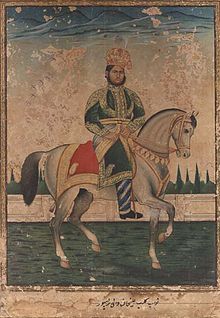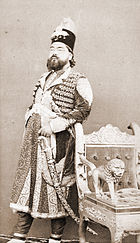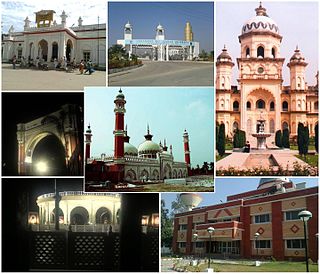
Rampur ( ) is a city, and the municipality headquarter of Rampur District in the Indian state of Uttar Pradesh. It was formerly known for its various industries, like sugar refining and cotton milling. Its library has more than 12,000 rare manuscripts and a fine collection of Mughal miniature paintings. It is located 322 kilometres north-west of the state capital Lucknow.
Nawab, also spelled Nawaab, Navaab, Navab, Nowab, Nabob, Nawaabshah, Nawabshah or Nobab, is a royal title indicating a sovereign ruler, often of a South Asian state, in many ways comparable to the western title of Prince. The relationship of a Nawab to the Emperor of India has been compared to that of the Kings of Saxony to the German Emperor. In earlier times the title was ratified and bestowed by the reigning Mughal emperor to semi-autonomous Muslim rulers of subdivisions or princely states in the Indian subcontinent loyal to the Mughal Empire, for example the Nawabs of Bengal.

Rohillas are a mixed Indian community of Pashtun heritage, historically found in Rohilkhand, a region in the state of Uttar Pradesh, India. It forms the largest Pashtun diaspora community in India, and has given its name to the Rohilkhand region. The Rohilla military chiefs settled in this region of northern India in the 1720s, the first of whom was Ali Mohammed Khan.

Saharanpur district is the northernmost of the districts of Uttar Pradesh state, India. Bordering the states of Haryana, Himachal Pradesh and Uttarakhand, and close to the foothills of Shivalik range, it lies in the northern part of the Doab region.
Ali Muhammad Khan was a Rohilla chief who founded the Kingdom of Rohilkhand in the northwestern region of the Uttar Pradesh state of India. He succeeded his foster father Sardar Daud Khan Rohilla at the age of fourteen and was generally regarded as a non-oppressive ruler to the masses. He was well regarded for his political ability, and was granted the right to use India's highest insignia of the Mahseer by the Emperor Muhammad Shah. His young death along with the tender age of his children led to Hafiz Rehmat Khan's regency which was in large part governed against his wishes, despite Rehmat Khan's solemn oath on the Quran to fulfill dying Ali Mohammad's will.
Begum Noor Bano served as a Member of Parliament in the 11th Lok Sabha and 13th Lok Sabha, lower house of parliament of India. She was elected from Rampur on the ticket of Indian National Congress party.

The Rampur Raza Library located in Rampur, Uttar Pradesh, India is a repository of Indo-Islamic cultural heritage established in the last decades of the 18th century. It was built up by successive Nawabs of Rampur and is now managed by the Government of India, named after Raza Ali Khan Bahadur.

The First Rohilla War of 1773–1774 was a punitive campaign by Shuja-ud-Daula, Nawab of Awadh on the behalf of Mughal Emperor, against the Rohillas, Indian descendants of Afghan highlanders settled in Rohilkhand, northern India. The Nawab was supported by troops of the British East India Company, in a successful campaign brought about by the Rohillas reneging on a debt to the Nawab.
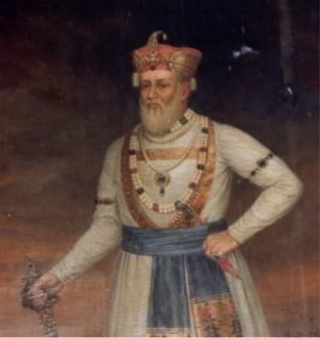
Nawab Faizullah Ali Khan was the first Nawab of Rampur. The princely state of Rampur was set up in year 1774, after the First Rohilla War, by the dismemberment of the Rohilla Kingdom of Rohilkhand. Faizullah Khan, the only surviving heir of Ali Mohammed Khan and opponent of the forces of Awadh and the British East India Company in the war, was installed as ruler of what was the newly created Rampur State. It bordered the Maratha Empire to the south, making it a strategic point. Under tutelage of the East India Company, Faizullah Khan ruled peacefully for 20 years. The capital Rampur was founded, and the Raza Library collection gathered.

Nawab Sayyid Hamid Ali Khan Bahadur was Nawab of the princely state of Rampur from 1889 to 1930.

Sir Raza Ali Khan BahadurGCIE, KCSI, NH, NI was a nawab of the princely state of Rampur from 1930 to 1966.
Nawab Murtaza Ali Khan Bahadur, MBE, NH, NI was the titular Nawab of Rampur from 1966 to his death in 1982, succeeding his father, Nawab Raza Ali Khan Bahadur.
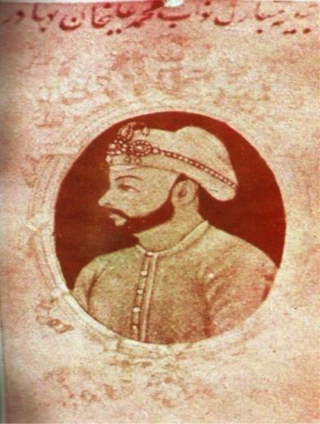
Nawab Muhammad Ali Khan Bahadur was the eldest son of Faizullah Khan and briefly Nawab of Rampur between 24 July and 11 August 1793 when he was deposed by his younger brother Ghulam Muhammad Khan Bahadur and exiled to Dungarpur. He died there a year later as a prisoner when he was shot in his sleep. His only son, Ahmad Ali Khan Bahadur, later became Nawab of Rampur.

Al-Haj Nawab Ghulam Muhammad Khan Bahadur was briefly Nawab of Rampur from 1793 to 1794. The younger son of Faizullah Khan, Ghulam Muhammad became Nawab in 1793 after deposing his elder brother, Muhammad Ali Khan Bahadur. His reign quickly took on a tyrannical aspect, and he was soon deemed a danger to the region's stability. Thus, in 1794, he was himself deposed by troops of the East India Company and of the Nawab of Awadh, being succeeded as Nawab by his nephew, Ahmad Ali Khan Bahadur. Ghulam Muhammad then undertook the Hajj, after which he fled to Mysore and Tipu Sultan, later settling in the Punjab. He died at Nadaun in 1828.

Nawab Ahmad Ali Khan Bahadur was Nawab of Rampur from 1794 to 1840, succeeding his brother Ghulam Muhammad Khan Bahadur. The only son of Muhammad Ali Khan Bahadur, Ahmad Ali was made Nawab following the deposition of his uncle Ghulam Muhammad by the British East India Company and the Nawab of Awadh. Ahmad Ali ruled for 46 years, although he reigned from 1794 to 1811 under a regency. He transformed the cultural fabric of Rampur and started a tradition of cultural involvement that has been maintained by his successors to the present day. In 1801, Rampur became a vassal of the HEIC following the cession of Rohilkand by the Nawab of Awadh. Ahmad Ali died on 5 July 1840, aged 52. As his only son had died young, he was succeeded as Nawab by his cousin, Muhammad Said Khan Bahadur.

Nawab Muhammad Said Khan Bahadur was Nawab of Rampur from 1840 to 1855, succeeding his cousin Ahmad Ali Khan Bahadur. The son of Ghulam Muhammad Khan Bahadur, Muhammad Said spent his early years in the service of the East India Company, eventually rising to the rank of Deputy Collector for Dudain. Although his father had been a tyrant during his brief reign, Muhammad Said by contrast proved to be a benevolent and progressive ruler, building irrigation works and establishing courts of law and an advanced legal code. Muhammad Said died on 1 April 1855 in his 69th year and was buried at Rampur. He was succeeded by his eldest son, Yusef Ali Khan Bahadur.
Major Nawab Sayyid Zulfikar Ali Khan Bahadur, NH was an Indian politician and an Indian army officer who ruled as Titular Nawab of Rampur from 1982 to 1992, succeeding his elder brother Murtaza Ali Khan Bahadur.

The Second Rohilla War was a conflict between the Kingdom of Awadh and East India Company, and the Rohillas of Rampur State in 1794.

The Kingdom of Rohilkhand was a late modern Indian kingdom under nominal Mughal suzerainty, that rose under the declining Mughal Empire in 1721 and continued to exist until 1774 when it was defeated by Oudh the British transformed its significantly reduced borders into the princely state of Rampur. Nawab Ali Mohammed Khan became the first Nawab of Rohilkhand, having been previously elected as overlord by various Afghan chiefs at the age of fourteen. He would carve out the future kingdom from the collapsing Mughal Empire and go on to the found the Rohilla dynasty. The crown would go on being held by the Rohillas until the kingdom came to an end in 1774, and thereafter the same dynasty would rule over Rampur.

The Rohilla dynasty was a dynasty that ruled over much of North-West Uttar Pradesh in the form of Rohilkhand and later until 1947, the Princely state of Rampur. At the height of their power the dynasty ruled over the Kingdom of Rohilkhand and held suzairnty over the Kingdom of Kumaon and Kingdom of Garhwhal.


